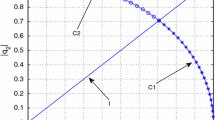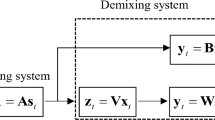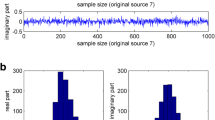Abstract
Bingham proposed a complex fast independent component analysis (c-FastICA) algorithm to approximate the nengentropy of circular sources using nonlinear functions. Novey proposed extending the work of Bingham using information from a pseudo-covariance matrix for noncircular sources, particularly for sub-Gaussian noncircular signals such as binary phase-shift keying signals. Based on this work, in the present paper we propose a new reference-based contrast function by introducing reference signals into the negentropy, upon which an efficient optimization FastICA algorithm is derived for noncircular sources. This new approach is similar to Novey’s nc-FastICA algorithm, but differs in that it is much more efficient in terms of the computational speed, which is significantly notable with a large number of samples. In this study, the local stability of our reference-based negentropy is analyzed and the derivation of our new algorithm is described in detail. Simulations conducted to demonstrate the performance and effectiveness of our method are also described.








Similar content being viewed by others
References
T. Adali, H.L. Li, M. Novey, J.F. Cardoso, Complex ICA using nonlinear functions. IEEE Trans. Signal Process. 56(9), 4536–4544 (2008)
S. Amari, A. Cichocki, H.H. Yang, A new learning algorithm for blind signal separation, in Advances in Neural Information Processing Systems, ed. by D. S. Touretzky, M. C. Mozer, M. E. Hasselmo, (Cambridge, MA: MIT Press, 1996), 8, pp. 757–763
E. Bingham, A. Hyvarinen, A fast fixed-point algorithm for independent component analysis of complex valued signals. Int. J. Neural Sys. 10(1), 1–8 (2000)
D.H. Brandwood, A complex gradient operator and its application in adaptive array theory. Proc. Inst. Elect. Eng. 130(1), 11–16 (1983)
M. Castella, E. Moreau, A new method for kurtosis maximization and source separation. in IEEE International Conference Acoust., Speech Signal Process (ICASSP2010), Dallas, TX, pp. 2670–2673 (2010)
M. Castella, E. Moreau, A new optimization method for reference-based quadratic contrast functions in a deflation scenario. in IEEE International Conference Acoust., Speech Signal Processing (ICASSP2009), Taipei, Taiwan, R.O.C., pp. 3161–3164 (2009)
M. Castella, E. Moreau, New kurtosis optimization schemes for MISO equalization. IEEE Trans. Signal Process. 60(3), 1319–1330 (2012)
S.C. Douglas, J. Eriksson, V. Koivunen, Fixed-point complex ICA algorithms for the blind separation of sources using their real or imaginary components. in Proceedings of 6th International Conference ICA BSS, Charleston, SC, pp. 343–351, (2006)
S.C. Douglas, Fixed-point algorithms for the blind separation of arbitrary complex-valued non-Gaussian signal mixtures. EURASIP J. Appl. Signal Process. 2007(1), 80–88 (2007)
L.T. Duarte et al., Application of blind source separation methods to ion-selective electrode arrays in flow-injection analysis. IEEE Sens. J. 14(7), 2228–2229 (2014)
J. Eriksson, V. Koivunen, Complex-valued ICA using second-order statistics, in Proceedings IEEE Workshop Machine Learning for Signal Processing (MLSP), Sao Luis, Brazil, pp. 183–192, (2004)
Y.N. Guo et al., Edge effect elimination in single-mixture blind source separation. Circuits Syst. Signal Process. 32(5), 2317–2334 (2013)
A. Hyvarinen, E. Oja, Independent Component Analysis by general nonlinear Hebbian-like learning rules. Signal Process. 64, 301–313 (1998)
A. Hyvarinen, E. Oja, A fast fixed-point algorithm for independent component analysis. Neural Netw. 10(3), 626–634 (1999)
A. Hyvarinen, E. Oja, Independent component analysis: algorithms and applications. Neural Netw. 13(4–5), 411–430 (2000)
H. Li, T. Adali, Gradient and fixed-point complex ICA algorithms based on kurtosis maximization, in Proceedings of IEEE Workshop Machine Learning for Signal Processing (MLSP), Maynooth, Ireland, pp. 85–90, (2006)
J.H. Li et al., De-multiplexing based on complex ICA for mode group diversity multiplexing system. Opt. Quantum Electron. 47(2), 217–224 (2015)
Y.B. Li, W. Nie, F. Ye, A complex mixing matrix estimation algorithm based on single source points. Circuits Syst. Signal Process. 34, 1–15 (2015)
X.L. Li, T. Adali, Blind separation of noncircular correlated sources using Gaussian entropy rate. IEEE Trans. Signal Process. 59(6), 2969–2975 (2011)
X.L. Li, T. Adali, Noncircular complex ICA by generalized householder reflections. IEEE Trans. Signal Process. 61(24), 6423–6430 (2013)
G.R. Naik, D.K. Kumar, M. Palaniswami, Signal processing evaluation of myoelectric sensor placement in low-level gestures: sensitivity analysis using independent component analysis. Expert Syst. 31(3), 91–99 (2014)
G.R. Naik, K.G. Baker, H.T. Nguyen, Dependence independence measure for posterior and anterior EMG sensors used in simple and complex finger flexion movements: Evaluation using SDICA. IEEE J. Biomed. Health Inform. 19(5), 1689–1696 (2015)
F. Neeser, J. Massey, Proper complex random processes with applications to information theory. IEEE Trans. Inf. Theory 39(4), 1293–1302 (1993)
M. Novey, T. Adali, ICA by maximization of non-Gaussianity using complex functions. presented at Proceedings of IEEE Workshop Machine Learning for Signal Processing (MLSP), Mystic, CT, (2005)
M. Novey, T. Adali, On extending the complex FastICA algorithm to noncircular sources. IEEE Trans. Signal Process. 56(5), 2148–2154 (2008)
M. Novey, T. Adali, Complex ICA by negentropy maximization. IEEE Trans. Neural Netw. 19(4), 596–609 (2008)
G. Pendharkar et al., Using blind source separation on accelerometry data to analyze and distinguish the toe walking gait from normal gait in ITW children. Biomed. Signal Process. Control. 13, 41–49 (2014)
T.L. Peng, Y. Chen, Z.L. Liu, A time-frequency domain blind source separation method for underdetermined instantaneous mixtures. CIrcuits Syst. Signal Process. 34, 1–13 (2015)
A. van den Bos, Complex gradient and Hessian, in Proceedings of Inst. Elect. Eng. Image Signal Process., 141, pp. 380–382, (1994)
W.V.D. Wijesinghe, G.M.R.I. Godaliyadda, M.P.B. Ekanayake, H.K. Garg, A generalized ICA algorithm for extraction of super and sub Gaussian source signals from a complex valued mixture. in IEEE 8th International Conference on Industrial and Information Systems (ICIIS2013), Aug. 18–20, Sri Lanka, pp. 144–149, (2013)
W. Wirtinger, Zur formalen theorie der funktionen von mehr complexen veranderlichen. Math. Ann. 97, 357–375 (1927)
K.P. Yu, K. Yang, Y.H. Bai, Estimation of modal parameters using the sparse component analysis based underdetermined blind source separation. Mech. Syst. Signal Process. 45(2), 302–316 (2014)
M.C. Yu et al., ICA of full complex-valued fMRI data using phase information of spatial maps. J. Neurosci. Methods 249, 75–91 (2015)
W. Zhao, Y.H. Shen, J.G. Wang, Z.G. Yuan, and W. Jian, New methods for the efficient optimization of cumulant-based contrast functions, in Proceedings of the 5th IET International Conference Wireless, Mobile and Multimedia Netw. (ICWMMN 2013), Beijing, China, PP. 345–349, (2013)
W. Zhao, Y.H. Shen, Z.G. Yuan, Y.M. Wei, Y.F. Cao, P.C. Xu, W. Jian, An efficient and robust algorithm for BSS by maximizing reference-based negentropy. Int. J. Electron. Commun. (2105), doi: 10.1016/j.aeue.2015.05.008. (Published online)
W. Zhao, Y.M. Wei, Y.H. Shen, Z.G. Yuan, P.C. Xu, W. Jian, A novel FastICA method for the reference-based contrast functions. Radioengineering 23(4), 1221–1225 (2014)
W. Zhao, Y.H. Shen, Z.G. Yuan, D.W. Liu, P.C. Xu, Y.M. Wei, W. Jian, N. Sha, A novel method for complex-valued signals in independent component analysis framework. Circuits Syst. Signal Process. 34(6), 1893–1913 (2015). doi:10.1007/s00034-014-9929-8
Acknowledgments
This work is supported by the NSF of Jiangsu Province of China under Grant No. BK2012057, and by the National Natural Science Foundation of China under Grant Nos. 61172061 and 61201242.
Author information
Authors and Affiliations
Corresponding author
Appendix
Appendix
First, we make orthogonal changes to coordinates \({\mathbf{p}} = {{\mathbf{A}}^H}{\mathbf{w}}\) and \({\mathbf{q}} = {{\mathbf{A}}^H}{\mathbf{v}}\) under the condition that reference signals update following objective signals, which results in the contrast function \(I\left( {{\mathbf{p}},{\mathbf{q}}} \right) = E\left\{ {G\left( {y{z^ * }} \right) } \right\} \), where \(y = {{\mathbf{w}}^H}{\mathbf{x}} = {{\mathbf{p}}^H}{\mathbf{s}}\) and \(z = {{\mathbf{v}}^H}{\mathbf{x}} = {{\mathbf{q}}^H}{\mathbf{s}}\). Without a loss of generality, we assume an optimal solution for \({s_1}\) at \({{\mathbf{p}}_1} = {\left[ {{e^{j\theta }},0, \ldots ,0} \right] ^T}\), where \(\theta \) points toward the direction of the principal component of \({s_1}\), as shown in [24].
Second, similar to the approach in [25], we seek a Taylor series expansion of I around the optimal solution \({{\mathbf{p}}_1}\), and obtain the gradient and Hessian matrices in the complex domain by differentiating with respect to \({\mathbf{p}}\) while treating \({{\mathbf{q}}^ * }\) as a constant. Similar to (18), we use (3)–(6), and the complex gradient defined in [29] to obtain the gradient as
where the middle term holds because \({\mathbf{q}}\) updates following \({\mathbf{p}}\) such that the values of \(\frac{{\partial I}}{{\partial {p_i}}}\) and \(\frac{{\partial I}}{{\partial {q_i}}}\) are the same. In addition, the Hessian can be written as
and similar to (19), we reformulate the Hessian in (31) as
Here, \(c = g'\left( {y{z^ * }} \right) {z^ * }^2\) and \(d = g'\left( {y{z^ * }} \right) {y^2}\).
Evaluating the gradient (30) and Hessian (32) at \({{\mathbf{p}}_1}\) and \({{\mathbf{q}}_1}\), we get
and
where \({{\mathbf{B}}_1} = \left( {\begin{array}{cc} 0&{}{E\left\{ {{{\left| {{s_1}} \right| }^4}g'\left( {{{\left| {{s_1}} \right| }^2}} \right) } \right\} {e^{j2\theta }}} \\ {E\left\{ {{{\left| {{s_1}} \right| }^4}g'\left( {{{\left| {{s_1}} \right| }^2}} \right) } \right\} {e^{ - j2\theta }}}&{}0 \end{array}} \right) \) and \({{\mathbf{B}}_i} = \left( {\begin{array}{cc} 0 &{} {E\left\{ {s_i^2} \right\} E\left\{ {g'\left( {{{\left| {{s_1}} \right| }^2}} \right) s{{_1^ * }^2}} \right\} {e^{j2\theta }}} \\ {E\left\{ {s{{_i^ * }^2}} \right\} E\left\{ {g'\left( {{{\left| {{s_1}} \right| }^2}} \right) {s_1}^2} \right\} {e^{ - j2\theta }}}&{}0 \end{array}} \right) \).
Thirdly, we make a small perturbation \({{\varepsilon }} = {\left[ {\begin{array}{cccc} {{\varepsilon _1}}&{{\varepsilon _2}}&\ldots&{{\varepsilon _N}} \end{array}} \right] ^T}\) around the optimal solution \({{\mathbf{p}}_1}\) using the complex Taylor series expansion shown in [29] as
Under the constraint \(\left\| {\mathbf{p}} \right\| = 1\), and using \({\left\| {{{\mathbf{p}}_1} + {{\varepsilon }}} \right\| ^2} = 1 + {\varepsilon _1}{e^{ - j\theta }} + \varepsilon _1^ * {e^{j\theta }} + {\sum \nolimits _{i = 1}^N {\left| {{\varepsilon _i}} \right| } ^2}\), we have
Substituting (36) into (35), we obtain
where the terms \({\left| {{\varepsilon _1}} \right| ^2}\) and \({\left( {{{\sum \nolimits _{i = 1}^N {\left| {{\varepsilon _i}} \right| } }^2}} \right) ^2}\) are of order \(o\left( {{{\left\| {{\varepsilon }} \right\| }^2}} \right) \) according to (36) and can be neglected, resulting in
where \({\varphi _i} = \arg \left( {\varepsilon _i^{ * 2}} \right) + \arg \left( {E\left\{ {s_i^2} \right\} } \right) + \arg \left( {E\left\{ {g'\left( {{{\left| {{s_1}} \right| }^2}} \right) s_1^{ * 2}} \right\} {e^{j2\theta }}} \right) \) is some arbitrary phase shift that results from
where the identity \(\mathrm{Z} + {\mathrm{Z}^ * } = 2{\mathrm{Z}^R} = 2\left| \mathrm{Z} \right| \cos \left[ {\arg \left( \mathrm{Z} \right) } \right] \) is used, in which \(\mathrm{Z} = \varepsilon _i^{ * 2}E\left\{ {s_i^2} \right\} E\left\{ {g'\left( {{{\left| {{s_1}} \right| }^2}} \right) s_1^{ * 2}{e^{j2\theta }}} \right\} \). The term \(\cos \left( {{\varphi _i}} \right) \in \left[ { - 1,1} \right] \) for any perturbation \({\varepsilon _i}\), resulting in the conditions for a local minimum (respectively, maximum) as
which must be satisfied for each source \({s_i}\), where \(i = \left[ {2,3, \ldots ,N} \right] \).
Finally, the local stability of our reference-based negentropy has been proved.
Rights and permissions
About this article
Cite this article
Zhao, W., Shen, Y., Xu, P. et al. Efficient Optimization of Reference-Based Negentropy for Noncircular Sources in Complex ICA. Circuits Syst Signal Process 35, 4390–4412 (2016). https://doi.org/10.1007/s00034-016-0274-y
Received:
Revised:
Accepted:
Published:
Issue Date:
DOI: https://doi.org/10.1007/s00034-016-0274-y




